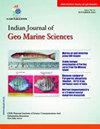Diet composition and feeding habits of flat needlefish Ablennes hians (Valenciennes, 1846) (Beloniformes: Belonidae) in the Southeastern Arabian Sea
IF 0.5
4区 地球科学
Q4 Earth and Planetary Sciences
引用次数: 0
Abstract
The study describes the feeding habits, diet composition and prey diversity of Ablennes hians based on 396 specimens collected between October 2015 and September 2017 from Kerala, south-west coast of India. The Index of Relative Importance (IRI) showed that teleosts were the most preferred food items (%IRI = 65.43 %) followed by molluscs (%IRI = 32.91) and crustaceans (%IRI = 1.66). Prey biodiversity analyses indicated no significant variation in the prey items between the sexes and immature (juvenile) and mature (adult) specimens. Similarly, a non-significant difference in Vacuity Index (VI) and Fullness Index (FI) was observed between the sexes (p > 0.05), juveniles, and adults (p > 0.05). Mean number of prey items per stomach (Nm/ST) was found to be higher in females and juveniles than males and adults; whereas the mean weight of prey items per stomach (Wm/ST) was higher in females and adults. Analysis of similarities (ANOSIM) test also indicated that there was no significant difference in prey types and preferences between sexes (global R = -0.25, P > 0.05) and juveniles and adults (global R = 0.5, P > 0.05). Diet analysis revealed that the species is a carnivorous and active pelagic predator, predominately consuming teleost fishes and an opportunistic feeder and might perform vertical migrations in search of food. The present study provides a first reference on the detailed information on feeding biology of the flat needlefish, which can be used as a baseline information for future studies in the region.阿拉伯海东南部Ablennes hians (Valenciennes, 1846)扁平针鱼的饮食组成和摄食习性(针鱼目:针鱼科)
该研究基于2015年10月至2017年9月在印度西南海岸喀拉拉邦收集的396个标本,描述了Ablennes hians的摄食习性、饮食组成和猎物多样性。相对重要性指数(IRI)显示,硬鱼是最受青睐的食物(%IRI = 65.43%),其次是软体动物(%IRI = 32.91)和甲壳类(%IRI = 1.66)。猎物的生物多样性分析表明,不同性别、未成熟(幼虫)和成熟(成虫)的猎物种类无显著差异。同样,在真空指数(VI)和饱腹指数(FI)中观察到两性之间无显著差异(p >0.05),青少年和成人(p >0.05)。每胃平均捕获物数(Nm/ST)雌性和幼鱼高于雄性和成鱼;而雌鼠和成虫的平均每胃猎物重量(Wm/ST)较高。相似度分析(ANOSIM)也表明,不同性别之间的猎物类型和偏好没有显著差异(全局R = -0.25, P >0.05),幼鱼和成鱼(全球R = 0.5, P >0.05)。食性分析表明,该物种是一种活跃的远洋食肉动物,主要捕食硬骨鱼,并可能进行垂直迁徙以寻找食物。本研究为平针鱼摄食生物学的详细信息提供了第一个参考,可作为该地区今后研究的基础资料。
本文章由计算机程序翻译,如有差异,请以英文原文为准。
求助全文
约1分钟内获得全文
求助全文
来源期刊
CiteScore
1.50
自引率
0.00%
发文量
0
审稿时长
1.7 months
期刊介绍:
Started in 1972, this multi-disciplinary journal publishes full papers and short communications. The Indian Journal of Geo-Marine Sciences, issued monthly, is devoted to the publication of communications relating to various facets of research in (i) Marine sciences including marine engineering and marine pollution; (ii) Climate change & (iii) Geosciences i.e. geology, geography and geophysics. IJMS is a multidisciplinary journal in marine sciences and geosciences. Therefore, research and review papers and book reviews of general significance to marine sciences and geosciences which are written clearly and well organized will be given preference.

 求助内容:
求助内容: 应助结果提醒方式:
应助结果提醒方式:


